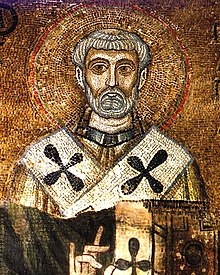
Back Pous Clemens I Afrikaans Clemens von Rom ALS Climent I AN كليمنت الأول Arabic القديس كليمنت الاول ARZ Papa Clemente I AST I Klement Azerbaijani Clemens vo Rom BAR Клімент I Byelorussian Клімэнт I (папа рымскі) BE-X-OLD
Clement I | |
|---|---|
| Bishop of Rome | |
 c. 1000 portrayal at Saint Sophia's Cathedral, Kyiv | |
| Church | Early Church |
| Papacy began | 88 AD |
| Papacy ended | 99 AD |
| Predecessor | Anacletus |
| Successor | Evaristus |
| Orders | |
| Consecration | by Saint Peter |
| Personal details | |
| Born | c. 35 AD |
| Died | 99 AD (aged 63-64) Chersonesus, Taurica, Bosporan Kingdom |
| Sainthood | |
| Feast day |
|
| Venerated in | |
| Attributes |
|
| Patronage |
|
| Shrines | Basilica di San Clemente, Rome St Clement's Church, Moscow Diocesan Shrine and Parish of St. Clement, Angono, Rizal, Philippines |
| Other popes named Clement | |
Clement of Rome (Latin: Clemens Romanus; Ancient Greek: Κλήμης Ῥώμης, romanized: Klēmēs Rōmēs) (c. 35 AD – 99 AD), also known as Pope Clement I, was the bishop of Rome in the late first century AD. He is listed by Irenaeus and Tertullian as the bishop of Rome, holding office from 88 AD to his death in 99 AD.[2] He is considered to be the first Apostolic Father of the Church, one of the three chief ones together with Polycarp and Ignatius of Antioch.[3]
Few details are known about Clement's life. Clement was said to have been consecrated by Peter the Apostle,[3] and he is known to have been a leading member of the Church in Rome in the late 1st century. Early church lists place him as the second or third [2][a] bishop of Rome. The Catholic Church lists him as the fourth pope. The Liber Pontificalis states that Clement died in Greece in the third year of Emperor Trajan's reign, or 101 AD. Eusebius, in his book Church History mentioned Clement as the third bishop of Rome and as the "co-laborer" of Paul.[4] In Against Heresies, Irenaeus describes Clement as the successor to Anacletus (third bishop of Rome), and a personal acquaintance of the Apostles.[5]
Clement's only genuine extant writing is his letter to the church at Corinth (1 Clement) in response to a dispute in which certain presbyters of the Corinthian church had been deposed.[2] He asserted the authority of the presbyters as rulers of the church on the ground that the Apostles had appointed such.[2] His letter, which is one of the oldest extant Christian documents outside the New Testament, was read in church, along with other epistles, some of which later became part of the Christian canon. These works were the first to affirm the apostolic authority of the clergy.[2] A second epistle, 2 Clement, was once controversially attributed to Clement, although recent scholarship suggests it to be a homily by another author.[2] In the legendary Clementine literature, Clement is the intermediary through whom the apostles teach the church.[2]
According to tradition, Clement was imprisoned under the Emperor Trajan; during this time he is recorded to have led a ministry among fellow prisoners. Thereafter he was executed by being tied to an anchor and thrown into the sea.[2] Clement is recognized as a saint in many Christian churches and is considered a patron saint of mariners. He is commemorated on 23 November in the Catholic Church, the Anglican Communion, and the Lutheran Church. In Eastern Orthodox Christianity his feast is kept on 24 or 25 November.
- ^ "Patron Saints and their feast days". pamphlets.org.au. Archived from the original on 22 June 2015. Retrieved 15 June 2015.
- ^ a b c d e f g h Cross, Frank Leslie; Livingstone, Elizabeth A. (2005). "Clement of Rome, St". The Oxford Dictionary of the Christian Church. Oxford University Press. p. 363. ISBN 978-0-19-280290-3.
- ^ a b Cite error: The named reference
CEwas invoked but never defined (see the help page). - ^ Roberts, Alexander; Donaldson, James (1885). Nicene and Post-Nicene Fathers: Series II. Vol. I (1st ed.). Church History of Eusebius, Book III, Chapter IV, 10.
- ^ Irenaeus. "Book III, Chapter 3". Ante-Nicene Fathers Vol. I.
Cite error: There are <ref group=lower-alpha> tags or {{efn}} templates on this page, but the references will not show without a {{reflist|group=lower-alpha}} template or {{notelist}} template (see the help page).
© MMXXIII Rich X Search. We shall prevail. All rights reserved. Rich X Search